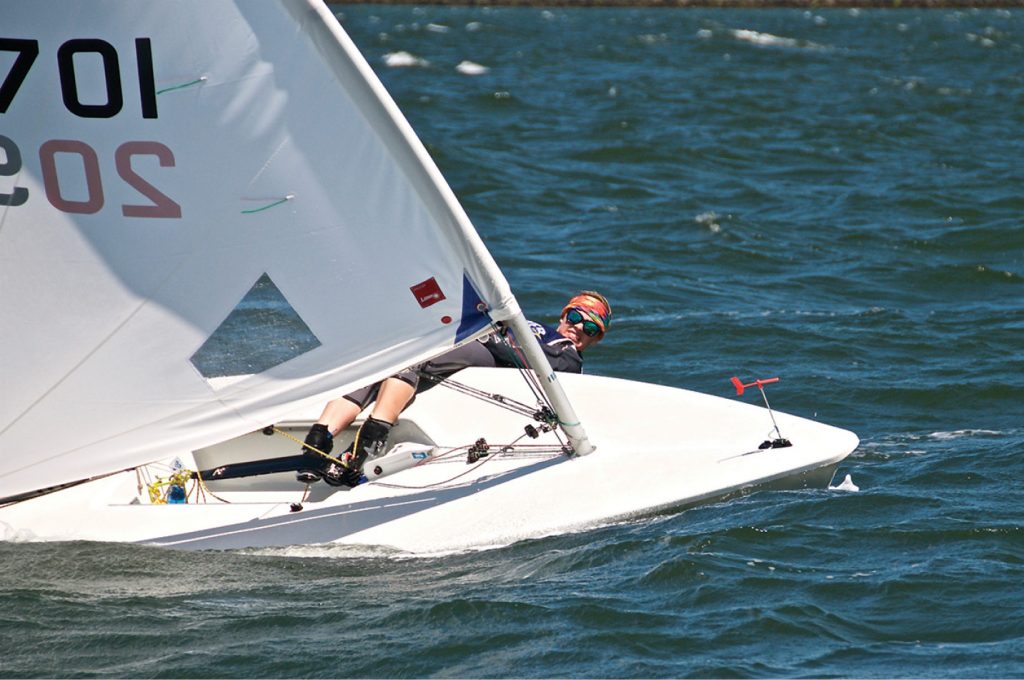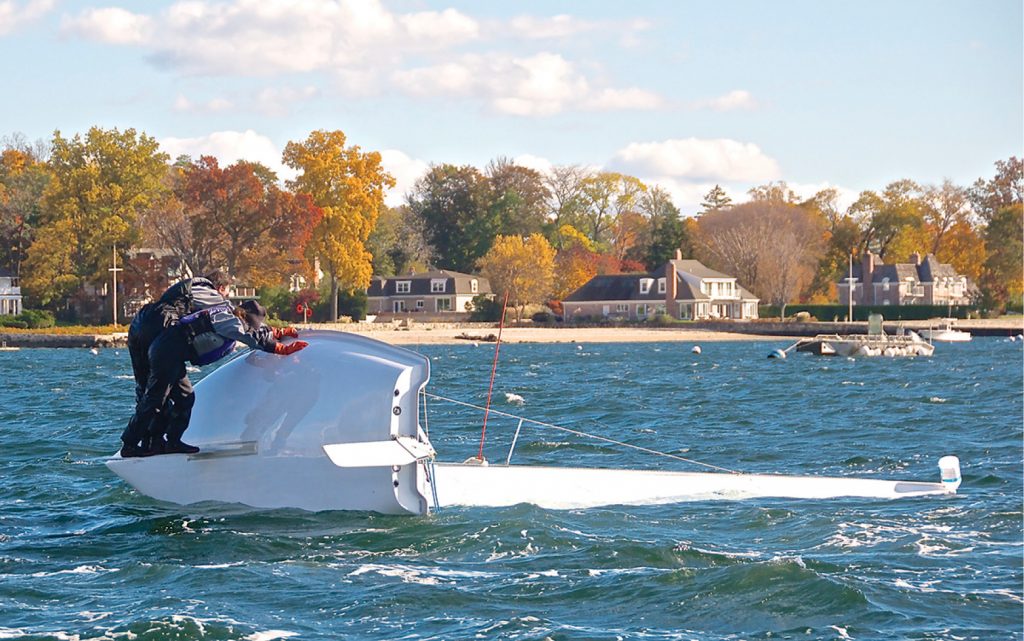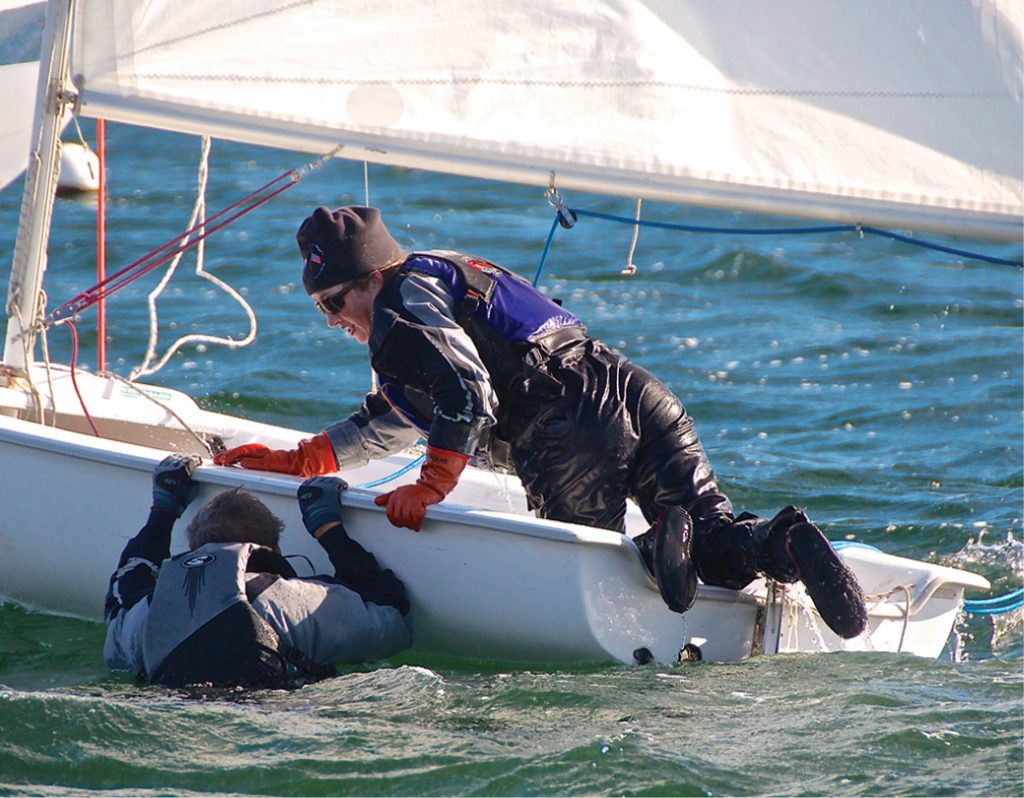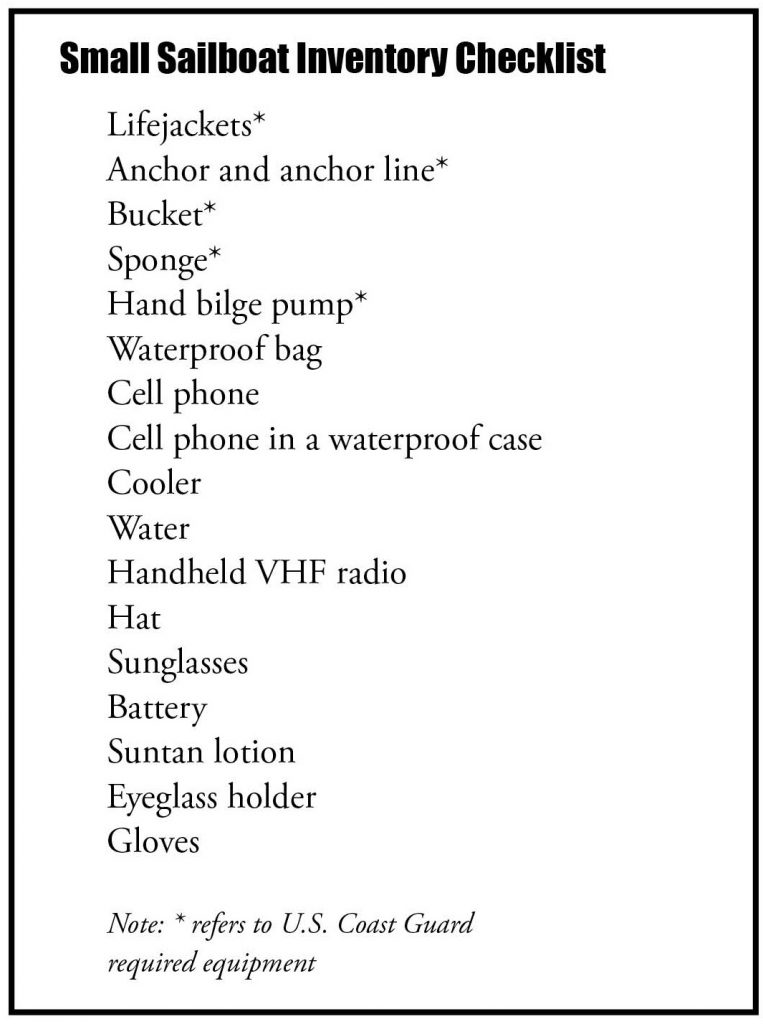By John McCabe

Keeping weight to windward and the centerboard (or daggerboard) fully lowered will reduce the boat’s tendency to capsize in a breeze. Photo courtesy of Rick Bannerot/OntheFlyPhoto.net
On my second date with a young lady in the early 1960s, she and I were sailing on a 19-foot Lightning on the Navesink River in New Jersey. The weather was picture-perfect, and my date was all dressed up for a day on the water. I was at the tiller. At some point I had to announce calmly that we were going to capsize. Reflecting back on what she heard, she recalls that she had a couple of seconds to think about what that meant, then, suddenly, she was up to her neck in the water. It all worked out OK though – we’ll soon be celebrating our 50th wedding anniversary! I have had the opportunity to be on a number of boats since then and have learned some important lessons on how to keep a small sailboat from capsizing and what to do if it does.
Have in mind that any sailboat can capsize, but let’s describe what “capsize” means. The mainsail prevents most boats from going over more than 90 degrees – at least for a short time. The mast, if made of metal, is hollow, and the air in the mast will keep it afloat, at least until it fills with water. With a sailboat with a fixed keel, the weight of the keel will right the boat more or less fairly soon. While sailing with a centerboard, the board will inhibit the boat from capsizing and like a keel, will push the boat forward when the wind hits the boat at an angle, rather than moving the boat directly sideways. When a sailboat has its centerboard down, the boat will be less likely to capsize, but if it does, the centerboard will help. With a little effort the centerboard will indeed help right the boat as discussed below.
What causes a small sailboat to capsize? It is often the misalignment of weight, not just the wind. Indeed, even in light wind, if the weight is misaligned, the boat can tip over. Weight sources are people and importantly the boom! When the weight of people is on one side, the tipping of the boat will cause the boom to move to that side by the force of gravity, not necessarily the wind. Indeed, in light winds the force of gravity on the boom can have a greater effect on the position of the boom than the force of the wind! Thus, in light air there is still the potential of capsizing if both the weight of people and boom are on one side. This brings us to the first rule that must be followed:
Rule 1: The centerboard must be fully down at all times when a sail is up.
Now, there may be times with the boat goes aground. For a keelboat, you can put the motor in reverse as strong as possible to see if the boat can be backed out of the mud or sand. At the same time you can try to rock the boat. For a small sailboat with the centerboard down, you can try to use the motor. Preferably, however, you should use an oar to push off from the bottom or oars to row off the bottom. The outboard motor propeller, if made of plastic, is meant to break if it hits a rock or a hard bottom. At this point, it is very tempting to raise the centerboard a few inches to loosen the boat from the bottom. But do not do this – you risk capsizing! First, take the sail down. Then maneuver the boat off the bottom using the oars, motor or other method. Again, fully lower the sail before raising the centerboard even an inch. Note Rule 1, above.
Rule 2: Don’t stand up in a small sailboat when underway.
This rule helps in weight distribution in as least three ways. First, because of the boom, it may be harder to move your body to the correct location on the boat, and second, if the boom, because of gravity or the wind, hits your body (hopefully not your head), it reinforces the force to capsize the boat at a higher center of gravity. Third, if your body or head is at or above the level of the boom, the boom cannot move to let the air out of the mainsail. This exacerbates the force that will tip the boat. Note that standing up is not the sole factor that can cause a boat to capsize, but it can be a contributing factor. At all times, keep low and be prepared to uncleat the mainsheet and let the sail out. Be prepared to shift weight rapidly if necessary, but otherwise keep a low profile and move slowly. In summary, don’t stand up in a small sailboat, except perhaps while boarding.

If you’ve capsized, climb onto the centerboard, grab the rail and use your weight to lever the boat upright. Note the empty 1-gallon bottle tied to the masthead, which helps prevent the boat from turning turtle. Photo courtesy of Rick Bannerot/OntheFlyPhoto.net
Rule 3: Be prepared at all times to let out the mainsheet or turn into the wind, or both, in moderate or heavy winds.
The recommendation here is the sailors should at all times know where the wind is coming from, its force, and where your boat is in relation to the wind. Keep your hand on the mainsheet so that it can be loosened and readjusted easily at any time. Also, keep your hand on the tiller so that the direction of the boat can be adjusted promptly. At all times be prepared to unclog the main sheet and let the sail out. Also, when do you reef the main sail? As soon as you think of it! – old sailor wisdom. Note that the farther the boom and sail are let out the more weight is put toward the side where the boom is located. But, ironically, you should let the sail out because it will catch less wind! Let it out a little or a lot, in your judgment. Alternatively, turn the boat into the wind. The preferred approach is to choose your direction, and then adjust the sails to achieve that direction, if possible.
Once you are on a tack in a small boat, do not jibe (change direction by turning in the direction the wind is blowing towards) except in light winds because you risk capsizing. Always “come about” (turn in the direction the wind is coming from) and call out in a strong enough voice “COMING ABOUT!” so all on board know what is happening and can change their position to be on the windward side of the boat. You can also say, “hard to lee” meaning the tiller is moved quickly and fully to the leeward side of the boat (in the direction the wind is blowing toward) forcing the boat to turn into the wind. Always have the mainsheet in hand, and I would suggest wearing gloves. Gloves also keep the sailor’s hands from getting sunburned, an added benefit. In summary, when at risk for capsize, let out the mainsheet and/or turn into wind. Preferably, let out the mainsheet.

Climb back aboard from the bow or stern. Attempting to board from the side may cause the boat to flip again. Photo courtesy of Rick Bannerot/OntheFlyPhoto.net
Rule 4: On a small sailboat, do not use the motor when the sail is up.
This rule may surprise some sailors. In a larger boat with a keel, you need to turn the motor on before bringing down the main sail because you will have no control over the boat direction when there are no sails up. On the other hand, in a small centerboard sailboat, if the motor is on and the crew is in the process of taking down the sails there is a risk of capsizing while the motor is in gear. This is dangerous because the prop will continue to turn even with the boat turned over 90 degrees. That presents a risk to those who may at that point be in the water. Understand that the motor can keep running if the boat capsizes unless it is shut off either by twisting the handle or using a magnetic disk release (See Rule 5). On a small sailboat, the motor must be off when taking the sails down. The boat will naturally head into the wind if the tiller is let go.
Rule 5: Use a magnetic disk engine shutoff and wristband when two or more people are on the boat.
Some electric outboard motors have a magnetic disk and a pad that will shut the motor off when and if the magnetic disk is separated from the pad. The magnetic disk has a wristband that may be used by the operator holding the tiller on the outboard. It is a good idea to use this wristband when underway with the outboard in gear. This is particularly true when there are two or more individuals on board a small boat. Again, if the boat capsizes or there is a man overboard, the motor will continue to run and the propeller turn unless the motor is shut off. This may be hard to do in an urgent situation or if a sudden, unexpected event occurs.
What to do if the small sailboat capsizes
A small sailboat may capsize, but it can be expected to turn over initially not more than about 90 degrees. This is enough to fill the boat with water and if left in that position, the mast may go down further in the water making the challenge of righting the boat more difficult. Accordingly, if the boat capsizes, take the following steps as quickly as possible:
- Account for all who were on board. Grab the lifejackets and put them on. Of course, make sure the life jackets are easily accessible before departure. [Better still, put them on before leaving the dock – Ed.] For inexperienced passengers, make sure their lifejackets are on before putting on your lifejacket. Of course, children 12 and under must wear lifejackets at all times. Always have lifejackets on board for all persons on board. An extra lifejacket can be tied to or placed on the top of the mast, which will keep the mast from sinking further into the water.
- Swim to the bottom side of the boat and stand on the centerboard, grabbing the rail until the boat rights itself. The boat will still be full of water, but it’s unlikely to sink. The water may even be at a level that is slightly below the edges of the coamings. However, water may be sloshing in and out of the boat at this time.
- Then enter the boat from either the bow or the stern – not the side. The bow will usually be better as the weight on the bow will not result in lowering the cockpit below the waterline and the motor in the back represents weight there. Hopefully, if there is a hole in the stern for the tiller, that hole will be moved above the waterline. The boat will float but it can still take on water. If’t is easier to board the boat from the stern, that’s OK too.
- Once in the cockpit, grab a bucket placed in the boat earlier (note boat inventory list below). Then, move to the forward side of cockpit to sit and bail. Why? The hole in the stern for the rudder will let in water and you may prevent this by being in the forward end of the cockpit. The tiller should be free, and the boat will normally point into the wind. Next, lower the sails if you can in this timeframe.
- The best position to sit when bailing out the boat is the forward portion of the cockpit, i.e., towards the bow. The crew member in the cockpit should place his or her back against the front of the cockpit (bow end of the coaming). If a second person is present, he or she should be in water at the bow to hold down the bow. Positioning the boat like a banana will aid in the bailout. Using the bucket, the crew member in the cockpit should bail the water out of the cockpit furiously in the beginning, until the water in the boat is at a level that he or she can bail at a more comfortable pace. It is quite feasible to remove 100% of the water from the boat using a combination of the bucket, a hand bilge pump and a sponge. When most of the water is out of the boat, a crew member in the water can enter the boat from the stern (not the side), being careful not to tip the boat over again.
- Wave for help if necessary. Also, if possible, a “Mayday” can be sent on VHF channel 16, monitored by the U.S. Coast Guard, or call 911 on your cell phone. Hopefully, the sail can be hoisted again and the boat can proceed to its destination.
Small Boat Inventory Checklist

If you avoid capsizing, you save grief, monetary loss (cell phone?) and perhaps greater risk. Safe sailing! I welcome any comments you may have on this article. Feel free to send them to john@mccabestudio.com. ■
John McCabe is a professional artist with a focus on portraiture (www.mccabestudio.com). He has studios in Milford, CT and Great Falls, VA. He and his wife, Peggy, have four children and seven grandchildren. They all sail out of Milford Harbor.



